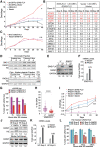RAD21 is a driver of chromosome 8 gain in Ewing sarcoma to mitigate replication stress
- PMID: 33766983
- PMCID: PMC8015718
- DOI: 10.1101/gad.345454.120
RAD21 is a driver of chromosome 8 gain in Ewing sarcoma to mitigate replication stress
Abstract
Aneuploidy, defined as whole-chromosome gain or loss, causes cellular stress but, paradoxically, is a frequent occurrence in cancers. Here, we investigate why ∼50% of Ewing sarcomas, driven by the EWS-FLI1 fusion oncogene, harbor chromosome 8 gains. Expression of the EWS-FLI1 fusion in primary cells causes replication stress that can result in cellular senescence. Using an evolution approach, we show that trisomy 8 mitigates EWS-FLI1-induced replication stress through gain of a copy of RAD21. Low-level ectopic expression of RAD21 is sufficient to dampen replication stress and improve proliferation in EWS-FLI1-expressing cells. Conversely, deleting one copy in trisomy 8 cells largely neutralizes the fitness benefit of chromosome 8 gain and reduces tumorgenicity of a Ewing sarcoma cancer cell line in soft agar assays. We propose that RAD21 promotes tumorigenesis through single gene copy gain. Such genes may explain some recurrent aneuploidies in cancer.
Keywords: DNA damage; Ewing sarcoma; RAD21; aneuploidy; cohesin; replication stress; trisomy 8.
© 2021 Su et al.; Published by Cold Spring Harbor Laboratory Press.
Figures






Similar articles
-
Loss of Stag2 cooperates with EWS-FLI1 to transform murine Mesenchymal stem cells.BMC Cancer. 2020 Jan 2;20(1):3. doi: 10.1186/s12885-019-6465-8. BMC Cancer. 2020. PMID: 31898537 Free PMC article.
-
EWS-FLI1 regulates a transcriptional program in cooperation with Foxq1 in mouse Ewing sarcoma.Cancer Sci. 2018 Sep;109(9):2907-2918. doi: 10.1111/cas.13710. Epub 2018 Jul 18. Cancer Sci. 2018. PMID: 29945296 Free PMC article.
-
Long noncoding RNA EWSAT1-mediated gene repression facilitates Ewing sarcoma oncogenesis.J Clin Invest. 2014 Dec;124(12):5275-90. doi: 10.1172/JCI72124. Epub 2014 Nov 17. J Clin Invest. 2014. PMID: 25401475 Free PMC article.
-
Blocking the road, stopping the engine or killing the driver? Advances in targeting EWS/FLI-1 fusion in Ewing sarcoma as novel therapy.Expert Opin Ther Targets. 2014 Nov;18(11):1315-28. doi: 10.1517/14728222.2014.947963. Epub 2014 Aug 27. Expert Opin Ther Targets. 2014. PMID: 25162919 Review.
-
Oncogenic partnerships: EWS-FLI1 protein interactions initiate key pathways of Ewing's sarcoma.Clin Cancer Res. 2010 Aug 15;16(16):4077-83. doi: 10.1158/1078-0432.CCR-09-2261. Epub 2010 Jun 14. Clin Cancer Res. 2010. PMID: 20547696 Free PMC article. Review.
Cited by
-
Comparative modeling reveals the molecular determinants of aneuploidy fitness cost in a wild yeast model.bioRxiv [Preprint]. 2024 Apr 13:2024.04.09.588778. doi: 10.1101/2024.04.09.588778. bioRxiv. 2024. Update in: Cell Genom. 2024 Oct 9;4(10):100656. doi: 10.1016/j.xgen.2024.100656. PMID: 38645209 Free PMC article. Updated. Preprint.
-
Subunit-specific analysis of cohesin-mutant myeloid malignancies reveals distinct ontogeny and outcomes.Leukemia. 2024 Sep;38(9):1992-2002. doi: 10.1038/s41375-024-02347-y. Epub 2024 Jul 20. Leukemia. 2024. PMID: 39033241 Free PMC article.
-
RAD21 promotes oncogenesis and lethal progression of prostate cancer.Proc Natl Acad Sci U S A. 2024 Sep 3;121(36):e2405543121. doi: 10.1073/pnas.2405543121. Epub 2024 Aug 27. Proc Natl Acad Sci U S A. 2024. PMID: 39190349 Free PMC article.
-
Seclidemstat blocks the transcriptional function of multiple FET-fusion oncoproteins.bioRxiv [Preprint]. 2024 May 21:2024.05.19.594897. doi: 10.1101/2024.05.19.594897. bioRxiv. 2024. PMID: 38826330 Free PMC article. Preprint.
-
TRACERx analysis identifies a role for FAT1 in regulating chromosomal instability and whole-genome doubling via Hippo signalling.Nat Cell Biol. 2025 Jan;27(1):154-168. doi: 10.1038/s41556-024-01558-w. Epub 2024 Dec 30. Nat Cell Biol. 2025. PMID: 39738653 Free PMC article.
References
Publication types
MeSH terms
Substances
Supplementary concepts
Grants and funding
LinkOut - more resources
Full Text Sources
Other Literature Sources
